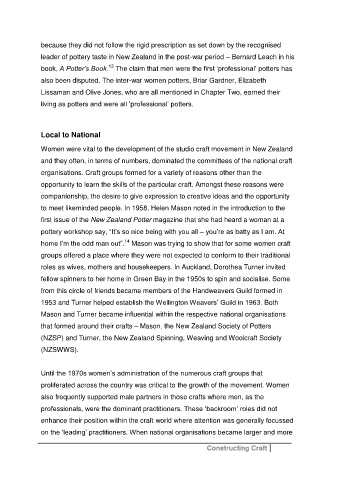Page 249 - Constructing Craft
P. 249
because they did not follow the rigid prescription as set down by the recognised
leader of pottery taste in New Zealand in the post-war period – Bernard Leach in his
13
book, A Potter’s Book. The claim that men were the first ‘professional’ potters has
also been disputed. The inter-war women potters, Briar Gardner, Elizabeth
Lissaman and Olive Jones, who are all mentioned in Chapter Two, earned their
living as potters and were all ‘professional’ potters.
Local to National
Women were vital to the development of the studio craft movement in New Zealand
and they often, in terms of numbers, dominated the committees of the national craft
organisations. Craft groups formed for a variety of reasons other than the
opportunity to learn the skills of the particular craft. Amongst these reasons were
companionship, the desire to give expression to creative ideas and the opportunity
to meet likeminded people. In 1958, Helen Mason noted in the introduction to the
first issue of the New Zealand Potter magazine that she had heard a woman at a
pottery workshop say, “It’s so nice being with you all – you’re as batty as I am. At
14
home I’m the odd man out”. Mason was trying to show that for some women craft
groups offered a place where they were not expected to conform to their traditional
roles as wives, mothers and housekeepers. In Auckland, Dorothea Turner invited
fellow spinners to her home in Green Bay in the 1950s to spin and socialise. Some
from this circle of friends became members of the Handweavers Guild formed in
1953 and Turner helped establish the Wellington Weavers’ Guild in 1963. Both
Mason and Turner became influential within the respective national organisations
that formed around their crafts – Mason, the New Zealand Society of Potters
(NZSP) and Turner, the New Zealand Spinning, Weaving and Woolcraft Society
(NZSWWS).
Until the 1970s women’s administration of the numerous craft groups that
proliferated across the country was critical to the growth of the movement. Women
also frequently supported male partners in those crafts where men, as the
professionals, were the dominant practitioners. These ‘backroom’ roles did not
enhance their position within the craft world where attention was generally focussed
on the ‘leading’ practitioners. When national organisations became larger and more
Constructing Craft

